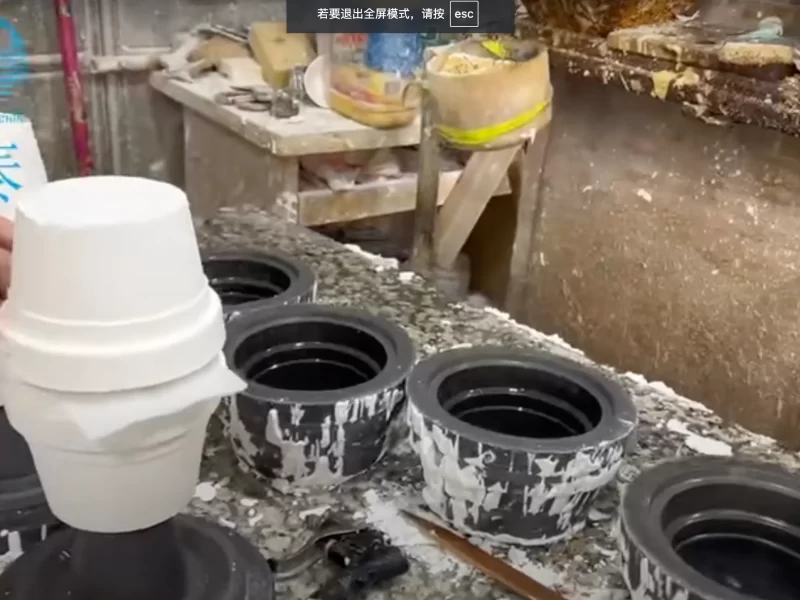
セラミック製造用型の作成にはいくつかの段階があり、作成したい特定の型(石膏型、シリコーン型、金属型など)によって工程が異なる場合があります。以下は、セラミック製造に使用される型の最も一般的な材料である石膏から通常作られるセラミック型を作成するための一般的なガイドです:
金型を設計する
鋳造したいものに応じて、詳細なデザインを作成します。これによって、必要なサイズ、形、型の種類が決まります。
金型が単純な形状であれば、1つの金型で済むかもしれないが、複雑な形状であれば、2分割の金型が必要になるかもしれない。
プロトタイプモデルの準備
原型は粘土、石膏、ワックスなどの材料で作ることができ、選択した金型材料に適合するものでなければならない。
原型が粘土でできている場合は、完全に乾いてから使用してください。石膏やワックスで作られた原型の場合は、そのまま型作りに使うことができる。
2分割の金型の場合、金型から取り出しやすくするために、モデルにわずかな面取りやテーパーがあることを確認する。
型枠を作る(2分割型を使用する場合)
プロトタイプモデルの周りにモールドフレーム(簡単な枠)を作る。この枠はモールド材料(石膏やシリコンなど)を保持し、モールドの外側の境界を定義します。
金型材料が対象物を完全に囲むことができるように、枠はモデルよりも大きくしてください。
2分割型の場合は、半分ずつ別の枠を作る必要がある。
離型剤を塗布する
型材を流し込む前に、模型の表面に離型剤(パラフィンや市販の離型剤など)を塗ります。こうすることで、型が固まった後、模型から型を簡単に外すことができます。
型材(石膏など)を混ぜて流し込む。
石膏を型材として使用する場合:
説明書に従って石膏と水を混ぜ、粒子がなく滑らかになっていることを確認する。気泡ができないように、ゆっくりと石膏を模型に流し込む。片隅から始め、石膏が自然に表面に流れるようにする。2液型の場合は、まず模型の半分を覆うように石膏を流し込み、固まるのを待ってから模型を石膏型から外す。次に、もう半分を覆うようにもう一度石膏を流し込み、固まるのを待つ。
金型を硬化させる
型を完全に硬化させる。型の大きさや厚さにもよりますが、通常数時間から1日かかります。
石膏型の場合は、完全に硬化させるために、風通しのよい場所に置いて乾燥させるのがよい。
プロトタイプモデルの削除
型が硬化したら、慎重に枠から型を外し、原型を傷つけないように注意しながら、原型から型をそっと切り離す。
原型が粘土やワックスでできている場合、その原型は比較的簡単に剥がすことができ、対象物にネガティブな印象を残すことができるはずだ。
金型の清掃と整理
原型を外した後、金型にキズや気泡がないか、トリミングが必要な箇所がないか確認する。
鋭利な道具や紙やすりを使って、型の細部が損なわれていないことを確認しながら、型を滑らかにする。
金型をテストする
正式に製造する前に、少量の粘土や鋳造材料で型をテストするのが最善です。
こうすることで、空気穴や通気口など、カビ効果に影響を与える可能性のある問題など、調整が必要な箇所を見つけることができる。
生産開始
金型がテストされ、要件を満たしたら、セラミック製造に使用することができます。
私達の専門の陶磁器の機械類プロダクト
必要な場合 セラミック製造用の高品質機械設備当社は、生産効率と品質を向上させるために設計されたセラミック金型製造設備、焼成設備などの総合的なセラミック機械ソリューションを提供しています。当社は、先進的なセラミック機械技術と高品質の製品を世界中のお客様に提供することに重点を置いています。より詳細な情報や技術サポートについては、お気軽にお問い合わせください。
